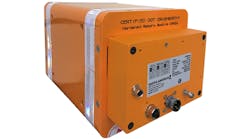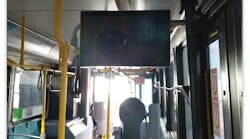Travelers are inundated with a wide range of sights and sounds as they pass through any busy transportation hub: Arrival, boarding and departure announcements, safety and security information, marketing and services messaging and the droning murmur of fellow travelers moving from point A to point B — it’s a flood of input for the senses at every step. Transportation managers are challenged to cut through clutter, capture attention and deliver actionable and, perhaps, critical safety information to a widespread, quickly-moving public.
Public address and emergency communications, primarily driven by audio technologies, are paramount to passenger movement, experience and safety. However, mass transit stations are not built with acoustics in mind, which can create significant challenges for audiovisual (AV) integrators. High ceilings and reflective surfaces abound and the background noise floor is high given all the passengers. Overhead announcements are a mix of pre-recorded messages and live pages sharing platform information or travel updates, such as late arrival details.
Depending on the size and nature of the transit station, a variety of individuals may need to make pages in the facility, including station agents, operations personnel, security staff, customs and immigration officers and emergency response teams. Each has unique requirements for paging and varying levels of urgency, making paging priorities a critical aspect of any new mass communication installation. Most announcements last anywhere from a few seconds to one to two minutes. Another important consideration for the paging system is the allowable length of a pre-recorded message, especially if multilingual versions are required. Therefore, public address systems must be easy to use and scalable as needed.
Knowing when to upgrade an existing paging system is complicated. Any change to the AV infrastructure requires a lot of planning, meetings with stakeholders and running the old system in tandem until cutover. System and code requirements for mass communications are increasingly complex, which can cause confusion when choosing a new paging or emergency communication system to install. There are several factors to consider when upgrading or installing a new paging system.
Intelligibility and acoustic modeling
Most transportation hubs have strict requirements for audibility and intelligibility per local or national fire codes such as NFPA 72. Think of the adage “loud and clear” — “loud” refers to audibility while “clear” refers to intelligibility. Both are critical to providing proper instructions in an emergency to building occupants.
Speech intelligibility is the percentage of speech a listener can understand. Intelligibility is affected by the volume level and quality of the speech signal, the type and level of background noise, room reverberation and more. It’s an essential consideration for AV systems in transportation hubs.
The larger the room or space, the more critical speech intelligibility becomes. If travelers can’t hear or understand announcements and instructions, their ability to learn and retain information is compromised. Intelligibility plays a significant role in information retention. If someone is in a reverberant space like a train station and all they hear is muffled speech, they’ll quickly give up trying to understand what’s being communicated and are likely to experience listener fatigue. The higher the speech intelligibility, the easier it is for listeners to retain information and understand what actions, if any, they need to take.
When designing AV systems for transportation hubs, consulting an acoustician or acoustical engineer and utilizing acoustic modeling software are recommended to ensure adequate coverage, audibility and intelligibility. Even in a retrofit or upgrade where the plan is to use the loudspeakers currently installed, acoustically modeling the space is still worthwhile (and sometimes required by code to meet certain thresholds of intelligibility), as is evaluating the possible degradation of the oldest loudspeakers.
Emergency communications
The security and safety of staff and passengers is the primary goal of all transit operators, making emergency communications critical for mass transit environments. People don’t behave normally in times of crisis so implementing systems that are easy to use is vital. The fewer steps needed to initiate emergency procedures, the better the chances of getting everyone to safety.
Life safety systems have stringent requirements for operation. For example, under NFPA 72, “public mode signaling” must provide and maintain a sound pressure level of 15 decibels above ambient sound levels. Authorities Having Jurisdiction may require passive or active line detectors on speaker runs to ensure the cable’s viability in case of fire or other emergencies. Reviewing the capabilities of potential emergency communication system upgrades is an important consideration during the selection process.
Improved customer experiences
Listener fatigue is a genuine concern for transportation hub operators. Not only can prolonged exposure to audio lead to physical and psychological discomfort, but mental exhaustion, as well. If an important announcement or emergency communication is shared, affected travelers may not be actively listening or respond appropriately. For example, when trains or subways arrive at stations, the squeal of the brakes can reach more than 100dB(A) on the platform. According to the Centers for Disease Control , hearing loss is possible in this environment in as little as 15 minutes of exposure.
Transit operators must consider passenger satisfaction as a factor in their communications system selection. The frequency of pre-recorded message playback should also be considered — it may not be necessary to play a constant stream of messages because passengers may block them out. Instead, consider a paging system that can also play background music, as studies have shown that certain types of music can have a calming effect.
Audio can play a crucial role in enhancing wayfinding and passenger flow in mass transit stations by providing clear and timely information to travelers, such as train arrivals and departures, platform changes, service disruptions and emergency instructions. Directional sound systems can guide passengers to various areas within the station and provide auditory cues for navigating ticketing areas, platforms, exits and other essential locations. Additionally, manual or pre-recorded audio cues can manage queues effectively by instructing passengers to maintain order, move forward or wait for their turn in specific areas.
Automation
Paging and mass communication systems are becoming increasingly sophisticated. For example, When an emergency is triggered, the paging system can automatically broadcast a pre-defined message to the entire transportation hub or pre-selected zones, depending on the nature of the emergency. Additionally, automation reduces the risk of human error during high-stress situations.
Automated messages help simplify operations in other ways. Many transit hubs broadcast warnings about detecting suspicious behavior or unattended luggage on a regular cadence. Scheduling messages of this nature frees up operations staff to focus on other matters.
Integration with other systems
Many transit facilities have separate systems based on function, such as a standalone life safety system entirely separate from the paging system, each with its own cabling. An economy of scale can be gained by integrating the systems or by having a single system that can perform multiple functions while typically being more cost-effective, easier to install and maintain.
Passenger information display systems can also be integrated with the paging system to share information. Some paging systems can create text-to-speech strings based on information received from outside systems, such as transit operators, track numbers and terminals.
Unifying audio communications with digital signage
Whether for routine or emergency announcements, audio broadcasts can be augmented by digital signage and visual reinforcement. For example, code requirements for fire safety require visual flashers of a certain brightness but flashers don’t provide information about the emergency itself. Passengers also have different learning methods and information retention levels so visual reinforcement can help a broader swath of people who may struggle with audio directives. Digital signage, visual displays and flashers can also aid with standards compliance, such as the Americans with Disabilities Act.
Final thoughts
Every passenger and staff deserves the clearest sound possible and intelligibility is especially critical in transportation hubs. When designing AV systems for transportation hubs — especially public address and emergency communication systems — consulting an acoustician or acoustical engineer and utilizing acoustic modeling software are recommended to ensure adequate coverage, audibility and intelligibility. Transit operators also need to look past the system requirements for ways to make staff and passengers’ lives easier, whether through automation, playing background music, decreasing audio fatigue or integrating the audio with other systems for improved efficiency. Anything that helps reduce travel-related stress will be looked upon favorably by everyone who passes through the doors.
Charles Kowalczyk is the domestic sales operations manager for AtlasIED.



